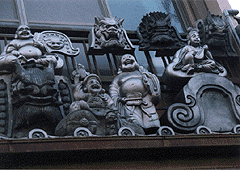 |
 |
Kyogawara
 Kyogawa refers to tiles (kawara) made in Kyoto. Kawara tiles first found its way to Japan from the Asian continent in the latter part of the sixth century. Kyogawara was originally used in the construction of the ancient capital, Heiankyo, by Emperor Kammu. Shortly before the Edo period, a famous kawara craftsman, Gorobe Nishimura of Fushimi Shinso, introduced a wave-like pattern kawara which incorporated characteristics of the flat and round kawara, which was used for many homes in the area. This lead to the booming production of kawarabuki (kawara houses) in Kyoto. In areas such as Nishigamo and Iwakura Hanko, where the quality of clay is suitable for kawara production, even now kawara kiln sites can be found. After the second World War, the variety of Kyogawara increased to nearly seven hundred types. The majority of kawara made in Kyoto are called "yakumono" (which serve as protective guardians who ward off evil) such as onigawara, demon faced tiles found on many temple roofes and little guardian figures standing on the eaves of people's homes. Its beauty and brilliance are its special feature which can only be found in these hand-made tiles. Kyogawa refers to tiles (kawara) made in Kyoto. Kawara tiles first found its way to Japan from the Asian continent in the latter part of the sixth century. Kyogawara was originally used in the construction of the ancient capital, Heiankyo, by Emperor Kammu. Shortly before the Edo period, a famous kawara craftsman, Gorobe Nishimura of Fushimi Shinso, introduced a wave-like pattern kawara which incorporated characteristics of the flat and round kawara, which was used for many homes in the area. This lead to the booming production of kawarabuki (kawara houses) in Kyoto. In areas such as Nishigamo and Iwakura Hanko, where the quality of clay is suitable for kawara production, even now kawara kiln sites can be found. After the second World War, the variety of Kyogawara increased to nearly seven hundred types. The majority of kawara made in Kyoto are called "yakumono" (which serve as protective guardians who ward off evil) such as onigawara, demon faced tiles found on many temple roofes and little guardian figures standing on the eaves of people's homes. Its beauty and brilliance are its special feature which can only be found in these hand-made tiles.
BACK


|
|